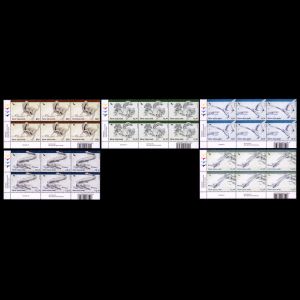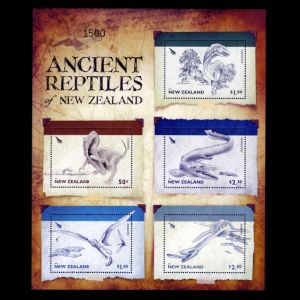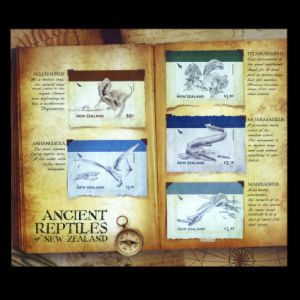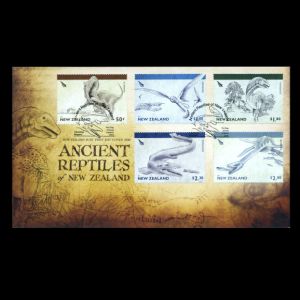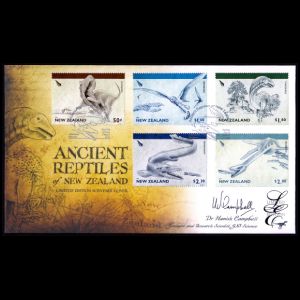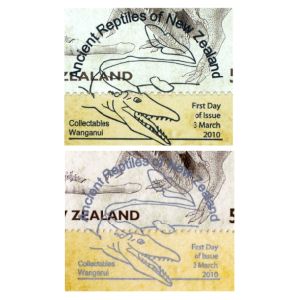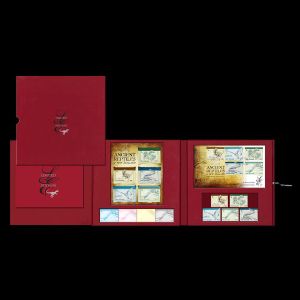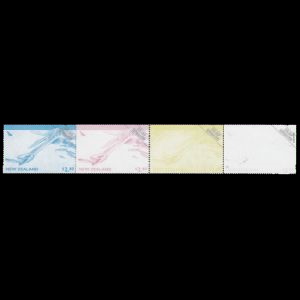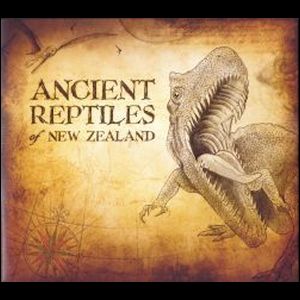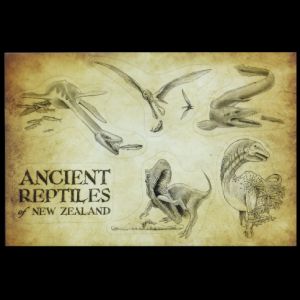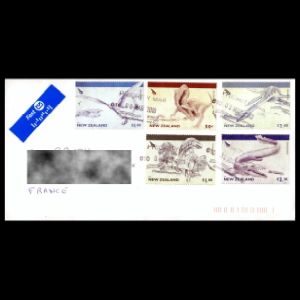New Zealand 2010 "Ancient Reptiles of New Zealand"
| <prev |
| Issue Date | 03.03.2010 |
| ID | Michel: 2670-2679 (mint), Bl. 254 (self-adhesive) Scott: 2293-2297 (mint), 2297a-e (self-adhesive) Stanley Gibbons: Yvert & Tellier: 2574-2578 (mint), 249 (self-adhesive) Category: pR |
| Author | Stamps and coins were produced by Eklektus Inc., Wellington, New Zealand: Graphic design was created by "The Alchemist". The coin cases by Izzat Design. Illustrations and writing by Eric Dorfman. |
| Stamps in set | 5 mint + 5 self-adhesive imperforated |
| Value |
50c - Allosaurus $1.00 - Anhanguera $1.80 - Titanosaurus $2.30 - Moanasaurus $2.80 - Mauisaurus |
| Size (width x height) | stamps: 52.0mm x 37.5 mm, Mini-Sheet of self-adhesive stamps: 230mm x 200mm |
| Layout | 20 stamps in sheet |
| Products | FDC x 1 PP x1, Gummed and self-adhesive stamps, Silver coins |
| Paper | Tullis Russell 104gsm red phosphor gummed stamp paper |
| Perforation | 14.40 x 14.60 |
| Print Technique | Offset lithography |
| Printed by | Southern Colour Print, Dunedin, New Zealand |
| Quantity | |
| Issuing Authority | New Zealand Post |
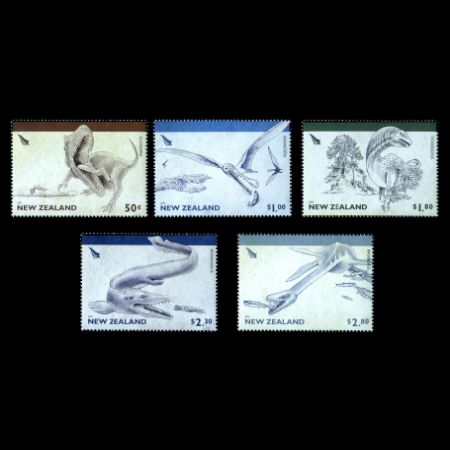
On 3rd March 2010, the Postal Authority of New Zealand issued the stamps set "Ancient Reptiles of New Zealand", as well as a set of coins.
Mint (gummed) stamps were issued in individual sheets of 20 and numbered mini-sheets of all 5 stamps were offered in the Limited Edition Packs (only 2,000 produced).
The Limited Edition Pack also contain a booklet with insightful commentary by renowned New Zealand geologist and palaeontologist Dr Hamish Campbell, as well as an FDC with his autograph.
The self-adhesive stamps were issued in sheets of 5 stamps only.
These stamps and coins were produced by Eklektus Inc - a collective that produced innovative visitor experiences in New Zealand and overseas.
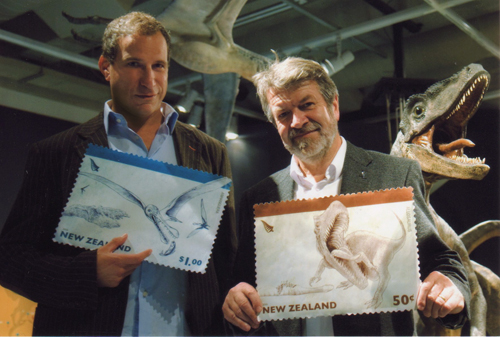
|
|
Eric Dorfman from Eklektus Inc (on the left) and Dr. Hamish Campbell from GNS Science (on the right)
in front of a dinosaur display at "Awesome Forces' -
The Museum of New Zealand Te Papa Tongarewa
on the launch day of the stamps. Image credit: Eklektus Inc. (the article does not exist anymore) |
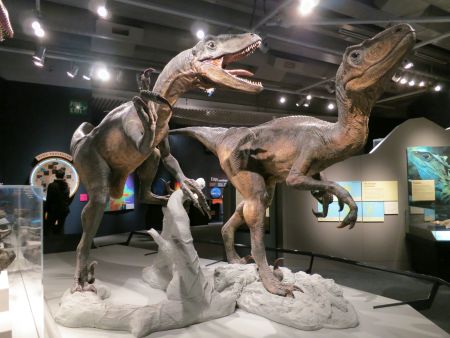
|
|
Dinosaurs reconstruction at The Museum of New Zealand Te Papa Tongarewa. Image credit: Traveler Trinkets |
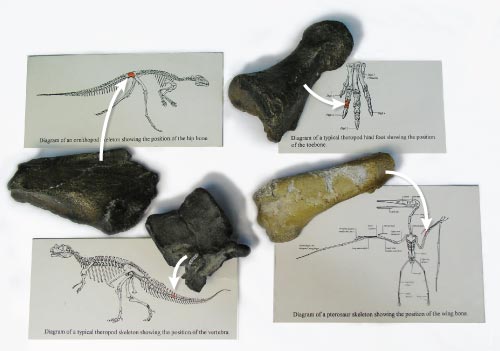
|
|
Dinosaur and pterosaur fossils of New Zealand. These diagrams show the skeletons of two types of dinosaur (ornithopod and theropod) and a pterosaur (flying reptile), and where fossil bone fragments fit into their reconstructed skeletons. All specimens are from Mangahouanga Stream, inland Hawke’s Bay, where New Zealand’s first dinosaur and pterosaur bones were unearthed. Image credit: The Encyclopedia of New Zealand |
The stamp presentation pack includes a map that shows the migration of prehistoric reptiles across the ancient supercontinent of Gondwana. It includes background information about the reptiles and even a couple of surprises. The coin case is beautifully crafted leather, designed to represent the adventurer’s journal.
Graphic design was created by "the Alchemist", the coin cases by Izzat Design, and illustrations and writing by Eric Dorfman. Paleontological assistance was provided by geologist and paleontologist Dr. Hamish Campbell from GNS Sciences, New Zealand. "Ancient Reptiles of New Zealand" explores the Cretaceous landscape, 70 million years ago, as if somebody were able to travel back in time and observe it directly. Illustrations on the stamps and coins were "field sketches" – reconstructions based on the most up-to-date information on animal behaviour, ecology and New Zealand palaeontology. Although there is an element of fantasy to the presentation, the facts reflect the most current scientific thinking.
The colourful three-panel presentation pack contain in-depth information, created in the style of a field researcher’s notebook and accompanied by five gummed stamps, a miniature sheet, a set of stickers, a first day cover (FDC) and an A2 map tracing the giant reptiles migration over the ancient super-continent of Gondwana.
The prehistoric animals depicted in this series include two dinosaurs: a theropod [Allosaurus) and a sauropod (Titanosaurus): two marine reptiles: a mosasaur (Moanasaurus) and an elasmosaur (Mauisaurus); and a flying reptile or pterosaur named Anhanguera.
These are very fine representations of these animals and they are based on substantive research by many palaeontologists over many years, but mainly on fossil discoveries in continental North America, South America, Africa, Europe and Asia.
The fossil remains of large animals have always fascinated mankind, and they can be found globally wherever there are suitable sedimentary rock formations. In this regard, New Zealand is no exception. A hundred million years ago, New Zealand's land formed the eastern margin of the southern super-continent of Gondwana . Separated by an ocean, "Zealandia" had its own group of dinosaurs, pterosaurs (flying reptiles) and giant marine reptiles that thrived here for 20 million years.
The New Zealand fossils to which these animals relate are fairly limited. For instance, our knowledge of the two dinosaurs Allosaurus and Titanosaurus is based on single bone fossils. They are both vertebrae (back bones) yet they are so distinctive that we can be quite certain of their identity. Similarly, only a few bones are known for the pterosaur, identified here as Anhanguera.
. Finding only individual bones of fragments from these animals makes it hard to identify them down to species level. A great deal more fossils are known for the marine reptiles, the short-necked Moanasaurus and the long-necked Mauisaurus. And there is a good reason for this: most of the Mesozoic sedimentary rocks of New Zealand are marine. Dinosaurs were strictly terrestrial animals and terrestrial rocks of the right age are surprisingly rare in New Zealand.
Conspicuous fossil bones and teeth exposed in and/or on natural rock surfaces have always been observed in various places around New Zealand. However, professional geologists were the first to collect Mesozoic fossil reptiles in New Zealand for scientific study and have done so since the 1850s. There is a national inventory of all known fossil localities in New Zealand and it includes all localities of Mesozoic reptile fossils. This the 'New Zealand Fossil Record File', administered by the Geological Society of New Zealand and GNS Science. GNS also maintains the National Paleontological Collections, and it is here that most collections of Mesozoic reptile fossils from New Zealand are kept, with smaller repositories held at regional museums and university collections.
The five representative Mesozoic reptiles depicted on the stamps serve as an unintentional but fitting tribute to the achievements of palaeontologist Joan Wiffen (1922-2008), who was shown on a stamp in 2022. Remarkably, she and her colleagues in the Hawke's Bay Palaeontology Group (a small club formed in the early 1970's by Joan and her husband Pont) have discovered fossils of all five of these animals at the one locality in sandstone formation of Late Cretaceous age, about 75 million years old.
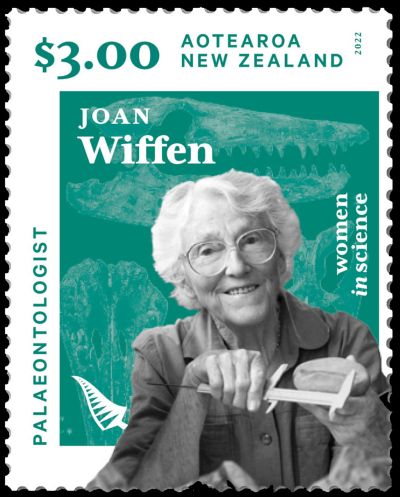 |
| Paleontologist Joan Wiffen stamp of New Zealand 2022, MiNr.: 3974, Scott: 3052. |
In the family’s search through geological survey maps trying to find likely places to search for fossils, Joan found a reference to rocks that contained ‘reptilian remains’ in a remote part of inland Hawke’s Bay. This comment can be attributed to observations made by Don Haw, a professional oil exploration geologist employed by British Petroleum (BP), who surveyed the Te Hoe Valley in the late 1950s and prepared a detailed report of his findings, including the discovery of fossil bones in Mangahouanga Stream. Associated fossil shells confirmed that the bone-bearing rock formation was a marine sandstone of Late Cretaceous age.
However, nobody followed this up at the time, stimulatinges Joan Wiffen to further search the area.
It took six months to get information on the locality and then to get permission from the landowner to visit. On Saturday 2nd December 1972 the Wiffens made their first visit to Mangahouanga Stream, which flows through steep, forest-covered hills of the Maungataniwha area of inland Hawke’s Bay.
The 'Maungataniwha' name, suggests that local Māori were aware of the fossil bones and attributed them to some unknown monster or 'taniwha'.
Collecting and transporting the fossils was hard, physical work. Access was by foot only, the terrain was extremely steep and rugged, and every rock they wanted to study at home had to be carried to the car on their backs.
After several months searching, they found their first fossil bone from a marine reptile. This was the beginning of many discoveries of other marine reptile fossils. During the next few years the team collected many marine reptile fossils and even the very first dinosaur fossil from New Zealand!
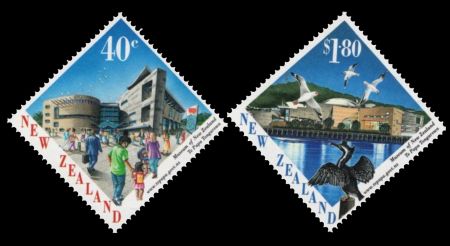 |
| Opening of New Zealand's National Museum (Te Papa) on stamps from 1998, MiNr.: 1657-1658, Scott: 1482-1483. |
Also housed at the Te Papa in Wellington is a remarkable dinosaur fossil
from Sussex, England.
It is a fossil tooth that is considered to be the very first fossil to be recognised as 'dinosaur'.
Its finding in a quarry near Cuckfield in 1820 is attributed to Mary-Anne Mantell, wife of
palaeontologist Gideon Mantell.
Gideon Mantell formally described his wife's famous fossil in 1822 and named it 'Iguanodon'.
It is housed in New Zealand because his son Walter built a career in the early colonial days of New
Zealand (1840s to 1880s) and was a key figure in the development of the Colonial Museum (now Te Papa).
He inherited his father's belongings in the 1850s, including the Iguanodon tooth.
Prehistoric animals of the stamps
Note: A large part of the following text was copied from the booklet included into the Limited Edition Pack. The text for the booklet was written by renowned New Zealand geologist and palaeontologist Dr. Hamish Campbell from GNS Sciences.50c - Allosaurus
At 12 metres long, Allosaurus was the largest meat eater on land in the region. It was at the top of the food chain and, it has been suggested, had a cooperative social behaviour, hunting in packs, much like lions do today. The dinosaur was able to open its jaws extremely widely, allowing it to attack large prey.
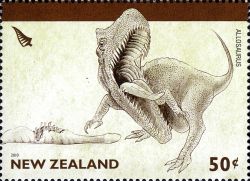 |
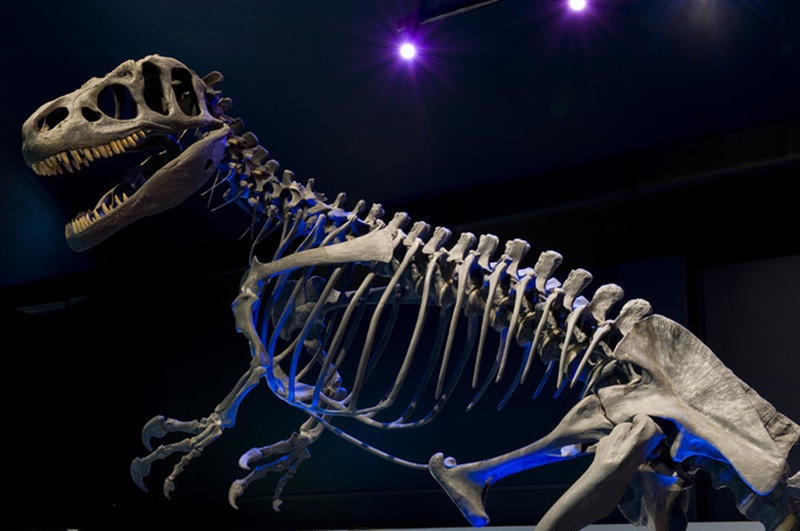 |
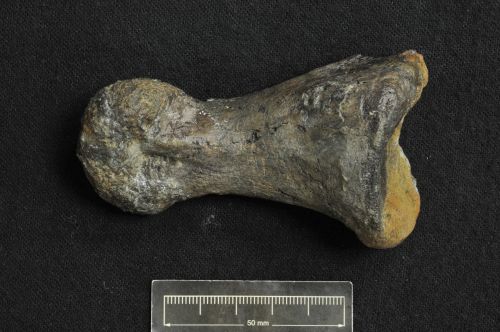 |
| Allosaurus on "Ancient Reptiles of New Zealand" stamp from 2010, MiNr.: 2670, Scott: 2293. | A life-sized replica Allosaurus skeleton can be seen in Canterbury Museum, Christchurch, New Zealand. Image credit: website of Canterbury Museum (the page doesn't exist anymore). | One of three bones that made up the toe of a meat-eating theropod that roamed prehistoric New Zealand in the Late Cretaceous. Image credit: GNS Science. |
The bulk of Allosaurus remains have come from North America's Morrison Formation, with material also known from Portugal (Allosaurus europaeus - appeared on several stamps of Portugal).
A life-sized replica Allosaurus skeleton can be seen in Canterbury Museum, Christchurch, New Zealand.
At the time of the stamp issue, only a single bone of Allosaurus was known from New Zealand.
In 1975, Joan Wiffen and her husband Pont discovered an unusual bone from the Mangahouanga Valley in Northern Hawkes Bay. It was small but clearly a backbone (vertebra). She puzzled over its identity for some years. Eventually she had it examined by vertebrate palaeontologist Dr. Ralph Molnar at Queensland Museum (Brisbane, Australia), who identified it as a tail bone of a carnivorous theropod dinosaur (Theropoda indet.).
It was the second dinosaur bone discovered in New Zealand. In 1974 Joan Wiffen extracted (using acid extraction) a therapod toe bone from a rock brought to her by a friend, Bill, who found it at the same location either earlier in the same year or in the previous excavation season (1973).
In February 1980, Wiffen and Molnar announced their findings at the 'Fifth International Gondwana Symposium' held in Wellington. It was a remarkable publication that rewrote the textbooks of New Zealand's natural history. Before then, there was no descriptions of dinosaurs who lived in the country. Most people believed that New Zealand had never had dinosaurs as the country had been isolated from other lands for so long that it did not seem likely.According to our knowledge today, during Mesozoic time, New Zealand was just part of continental eastern Gondwana and it was fairly close to the South Pole. Then about 83 million years ago, in Late Cretaceous time, the continent Zealandia, was rifted away and moved to the northeast with the formation of the Tasman Sea. Zealandia carried a cargo of Gondwanan plants and animals, including dinosaurs and pterosaurs.
$1.00 - Anhanguera
This pterosaur was the most common flying reptile in Zealandia. Fish eaters with a five-metre wingspan, they formed large coastal nesting colonies, similar to the seabirds of our time. They laid leathery eggs, and the flight centres in the brains of the young developed well before hatching, suggesting that they could fly from birth.
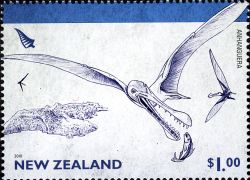 |
| Anhanguera pterosaur on "Ancient Reptiles of New Zealand" stamp from 2010, MiNr.: 2671, Scott: 2294. |
No pterosaur skulls or skeletons have been found in New Zealand, and the best preserved fossils are from Mangahouanga Stream. They include relatively complete bones and some isolated teeth that were discovered, collected, prepared and described by Joan Wiffen and her team.
One of the best preserved pterosaur fossils is a shoulder bone (scapula). This bone is most similar to the scapula of a pterosaur described from Cretaceous rocks in Brazil named Anhanguera (after a village with the same name meaning 'little devil' in Portuguese).
$1.80 - Titanosaurus
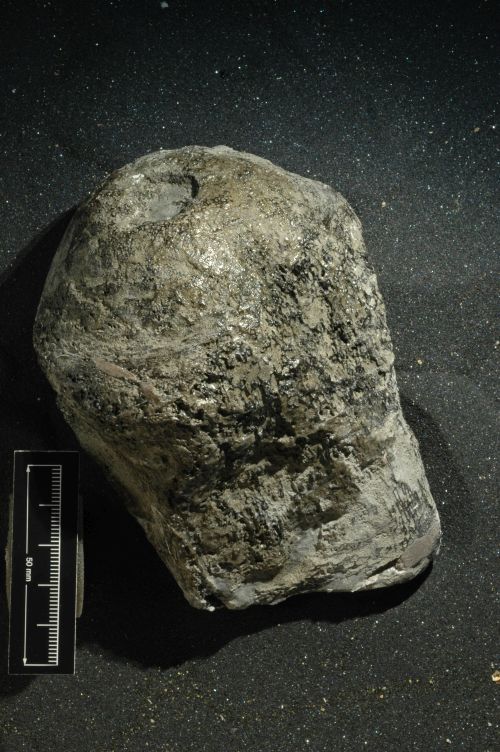 |
|
Titanosauridae bone discovered by Joan Wiffen at Mangahouanga Stream.
Dimensions - length: 130mm, width: 95mm (length), Height: 95mm (length). This specimen is part of the National Paleontological Collection, GNS Science. Image credit: GNS Science |
It was tall enough to browse the treetops and large ferns, travelling as part of an extensive herd to protect itself from predators.
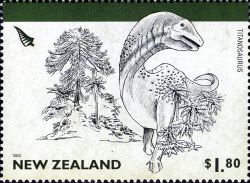 |
| Titanosaurus on "Ancient Reptiles of New Zealand" stamp from 2010, MiNr.: 2672, Scott: 2295. |
Titanosaurid fossils are cosmopolitan in that they are known from all continents (but not Antarctica as yet) including Zealandia, the New Zealand continent. They were also diverse. At least 40 different genera of dinosaur are attributed to the titanosaurids and more than 75 species. They were the dominant sauropods during Late Cretaceous time, 90-65 million years ago.
A single fossil, an incomplete back bone (vertebra), was recovered by Joan Wiffen from the Mangahouanga Stream locality in the 1990s. She and vertebrate palaeontologist Dr, Ralph Molnar formally described this fossil in 2008, less than a year before her death at age 87.
The fossil is so distinctive in terms of its size and shape that it can be confidently assigned titanosaurid, but more information is necessary to make a more specific determination of the genus or species to which this bone belongs. It relates to an animal that was about eight metres in length.
$2.30 - Moanasaurus
The mosasaurs (including Moanasaurus) were the top predators of the shallow coasts of Zealandia. At 12 metres long, with a 78-centimetre long skull, Moanasaurus would have been a fearsome predator, undulating its body through the water a little like a crocodile with paddled feet. Although mosasaurs were widespread across the world, Moanasaurus was specific to this region. They were strictly aquatic and they would have been air-breathing. Like modern marine mammals, they would have had to surface in order to breathe.
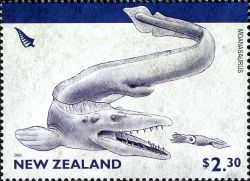 |
| Moanasaurus on "Ancient Reptiles of New Zealand" stamp from 2010, MiNr.: 2672, Scott: 2296. |
The main fossil localities are at Mangahouanga Stream (Hawke's Bay), Haumuri Bluff, Conway River, Waipara (Canterbury) and Shag Point (Otago).
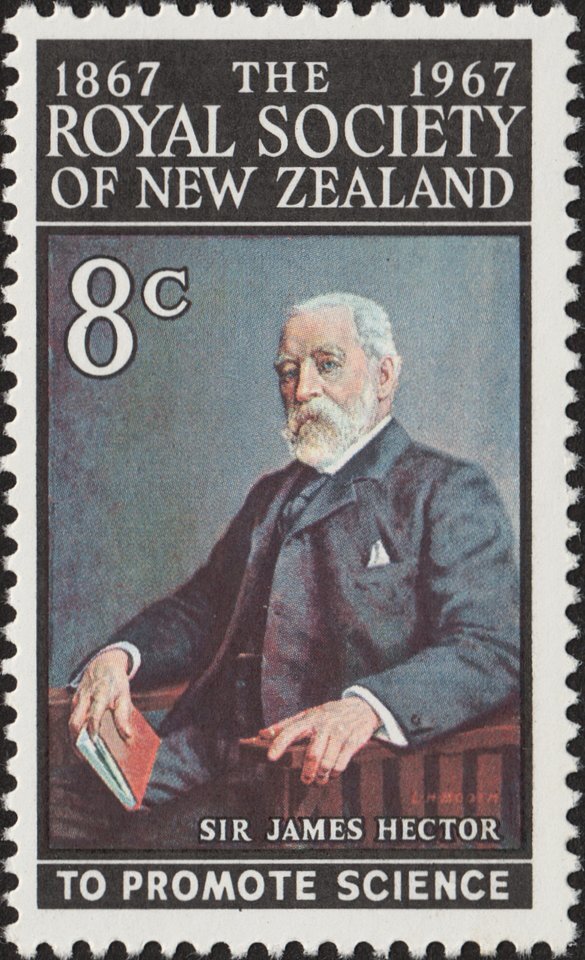 |
| Sir James Hector (1834-1907) on stamp of New Zealand from 1967, MiNr.: 479, Scott: 407. |
In 1874, James Hector who was Director of the Geological Survey of New Zealand, wrote in "On the Fossil Reptilia of New Zealand":
"The first notice of the occurrence in New Zealand strata of representatives of the Reptilian fauna characteristic of the mesozoic epoch, was made in 1861, when Professor Owen communicated to the British Association a brief description of certain fossils that had been discovered by Mr. T. H. Cockburn Hood, P.G.S., and presented by him to the British Museum. These fossil remains were obtained by Mr. Hood in a ravine on one of the tributaries of the Waipara River, at the northern extremity of the Canterbury plains. They comprise the vertebral centra, ribs, and coracoid bones, all belonging to the same individual which Professor Owen referred to a new species — Plesiosaurus australis.
No further discovery of Saurian remains was made till after the occurrence of a great flood, in 1868, when Mr. Hood again obtained a large collection, and shipped it to England, unfortunately, by the ship "Mataoka" which was lost on the homeward voyage. Dr. Haast, however, communicated a short account of this collection to the Philosophical Institute of Canterbury, and states that he
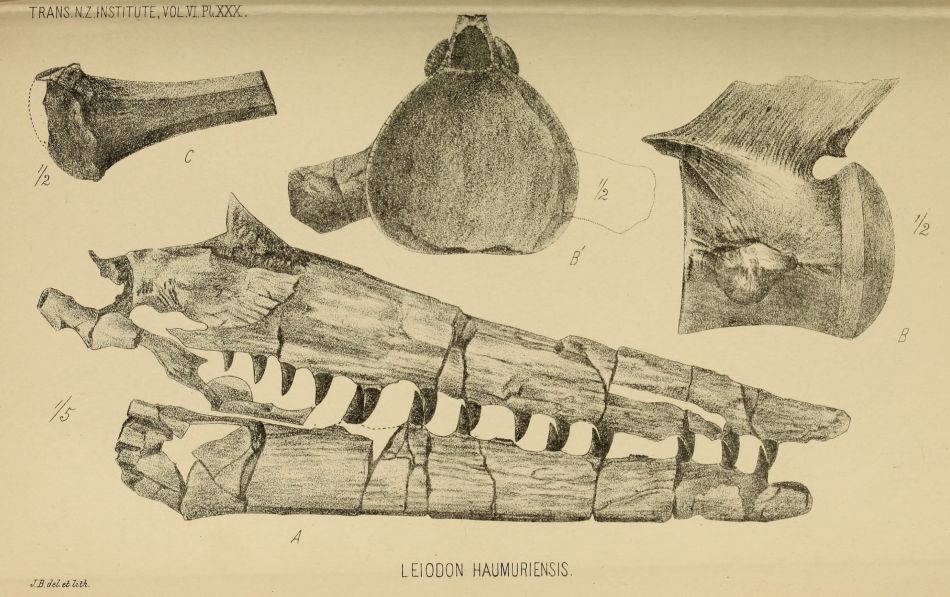 |
| In 1874 James Hector described some Mosasaur remains, now known as Taniwhasaurus haumuriensis. |
This foresight was most fortunate, as, notwithstanding the great number and variety of the remains since found, that collection appears to have contained the only skull fragment, with jaws and teeth, of a true Sauropterygian that has yet been discovered.
In 1867 I had visited the locality along with Mr. W. T. L. Travers, and obtained only a few fragments of these fossils; but after Mr. Hood's second discovery I sent Mr. R. L. Holmes, provided with the requisite appliances, to obtain a more complete collection for the Colonial Museum. Drawings of these, forwarded to Professor Owen, enabled him to add two new species, which he named Plesiosaurus crassicostatus and Plesiosaurus hoodii. In the following year Dr. Haast made a detailed survey of the district, and obtained a large series of Saurian and other fossils, which are now in the Canterbury Museum..."
Mosasaur fossils tend to be large as they relate to animals that were up to eight metres in length, and therefore preserve well, but they are very difficult to extract from solid rock. To do so is labour intensive and requires much skill and care. Nevertheless, over the years several relatively complete skeletons have been excavated and prepared, particularly at Canterbury Museum, Christchurch. But the most spectacular fossils are of skulls.
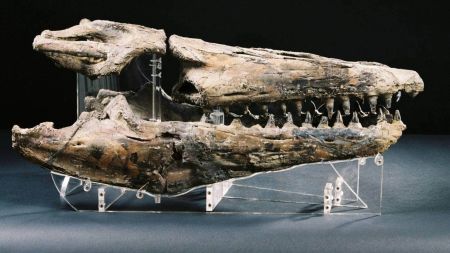 |
| This mosasaurus skull was discovered by the late Joan Wiffen in the Urewera range, then donated to GNS Science. Image credit: GNS Science |
All known mosasaur fossils in New Zealand are from sedimentary formations that originally accumulated as sand and silt on the sea floor. They are commonly associated with other fossils, mainly shellfish (molluscs) including ammonites and belemnites, and plankton (microfossils). At least six species of mosasaur have been described from New Zealand with genus names such as Prognathodon, Moanasaurus, Rikisaurus, Taniwhasaurus and Mosasaurus. (The skull of the Prognathodon overtoni is shown on the background of Joan Wiffen stamp of New Zealand 2022.) Some of these colourful names are distinctly New Zealand.
$2.80 - Mauisaurus
Mauisaurus was a 20-metre marine reptile (plesiosaur), the largest of its kind in the world. It was an "elasmosaur", the type of plesiosaur with a tiny head and very long neck.
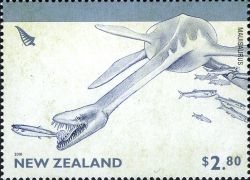 |
| Mauisaurus он "Ancient Reptiles of New Zealand" stamp from 2010, MiNr.: 2672, Scott: 2297. |
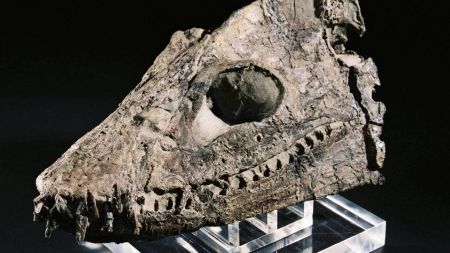 |
| This Elasmosaurus skull was discovered by the late Joan Wiffen in the Urewera range. This specimen is part of the National Paleontological Collection, GNS Science. Image credit: GNS Science. |
Their fossils have been found in marine sedimentary rocks (mainly sandstone and siltstone) of Late Cretaceous age, between 100 and 65 million years ago, all over the world.
A well preserved elasmosaur skull is part of the National Paleontological Collection at GNS Science.. This superb specimen was discovered by Joan Wiffen and her colleagues at Mangahouanga Stream, Te Hoe Valley, Hawke's Bay.
It was subsequently prepared and described by Joan Wiffen and vertebrate palaeontologist Dr Ralph Molnar, and formally named Tuarangisaurus keyesi.
The genus name relates to its New Zealand origins and means 'lizard from Tuarangi'. The species name honours Ian Keyes, a skilled fossil preparator, palaeontologist and curator with New Zealand Geological Survey, and a significant mentor to Joan Wiffen.
As with all other fossils at this locality, it is derived from the Maungataniwha Sandstone Formation.
Elasmosaurs bones are the most common vertebrate fossils that have been found at the Mangahouanga Stream locality, but as with mosasaur fossils, they are known from a number of other localities of Late Cretaceous age from elsewhere in New Zealand, especially at north Canterbury and Shag Point (Otago).
Thus far, three elasmosaur genera have been discovered from New Zealand, all with distinctive New Zealand names. They include Tuarangisaurus, Mauisaurus and Kaiwhekea.
The almost complete skeleton of Kaiwhekea from Shag Point was collected, prepared and described by Professor Ewan Fordyce and colleagues, and is on display at Otago Museum, Dunedin.
Since 2000, a more 'precise' age for the Maungataniwha Sandstone has been established on the basis of microfossils. The age is 75 million years, plus or minus one or two million. This is based on the presence of very distinctive microscopic dinoflagellates, which are a group of marine algae. These fossils look like geometric armour-plated capsules (they are reproductive vessels) with tassels at each corner, and are so tough that they can be extracted from hard rock using powerful acids.
Products
References:
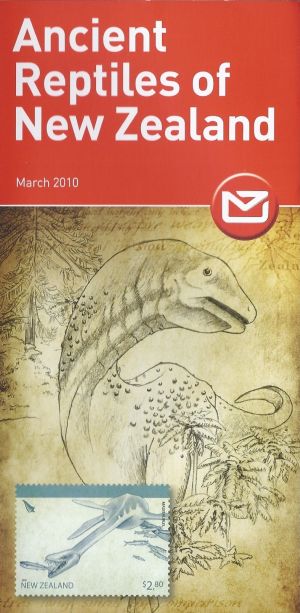
- Technical details and release notes:
NZpost [1] & [2], official flyer, Eklektus Inc. (the article is not available anymore).
"Ancient Reptiles of New Zealand", by Dr. Hamish Campbell, page 5 of Focus Magazine Nr. 49 from April 2010, - Joan Wiffen: Museum of New Zealand, Te Ara - the Encyclopedia of New Zealand, Science Learning Hub,
- Prehistoric animals of the stamps:
The booklet from the Limited Edition Pack, the text for the booklet was written by New Zealand geologist and palaeontologist Dr. Hamish Campbell from Institute of Geological and Nuclear Sciences (GNS) .
List of Dinosaurs and other Mesozoic reptiles of New Zealand: Wikipedia,
- Allosaurus: Wikipedia,
- Anhanguera: Wikipedia,
- Mauisaurus: Wikipedia,
- Moanasaurus: Wikipedia,
University of Otago,
"On the fossil reptiles of New Zealand", by James Hector, M.D., F.E.S., Director of the Geological Survey of New Zealand, published in Transactions and proceedings of the New Zealand Institute, vol 6, 1874 - Titanosaurus: Wikipedia, Science Learning Hub, Museum of New Zealand Te Papa Tongarewa
Acknowledgements:
Many thanks to
- Dr. Peter Voice from Department of Geological and Environmental Sciences, Western Michigan University, for the draft page review and his very valuable comments.
- Marianna Terezow, Manager – National Paleontological Collection, GNS Science for the draft page review, provided images and her very valuable comments.
| <prev |
